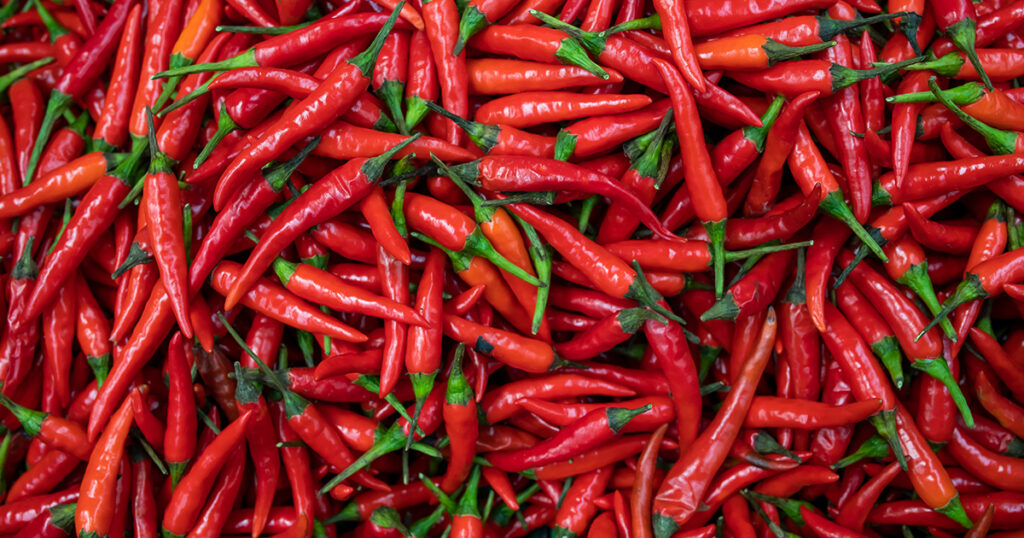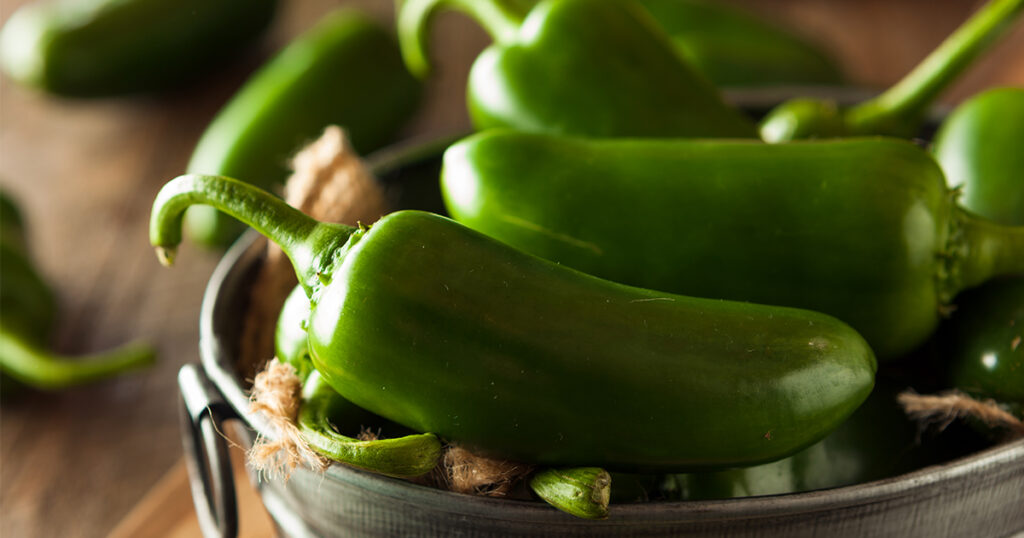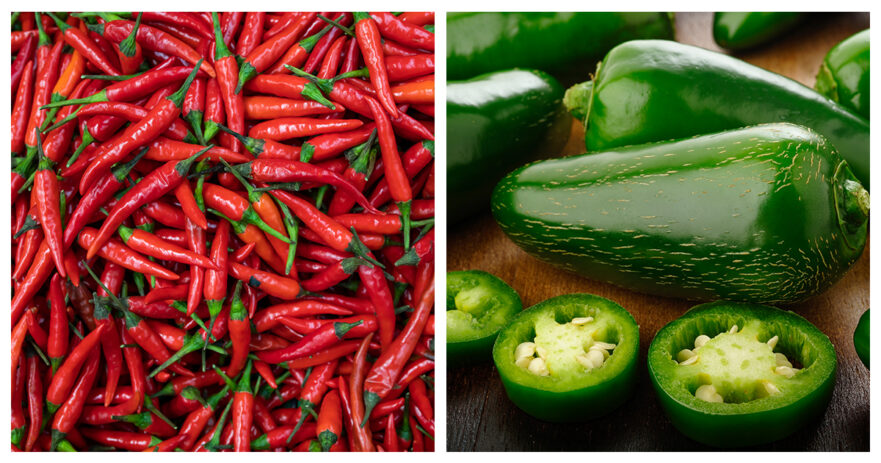The tantalizing heat of cayenne and jalapeño peppers is unmistakable for those who enjoy a spicy kick. They have been the fiery companions of many culinary masters, adding heat and flavor to countless dishes worldwide. These peppers are always ready to play their part, whether it’s the sizzle of a summer barbecue or the warmth of a winter stew.
| Cayenne pepper | Jalapeño pepper | |
| SHU | 30,000 - 50,000 | 2,500 - 8,000 |
| Median SHU | 40,000 | 5,250 |
| Flavor | Tangy, sligthly fruity, moderatly hot | Grassy, vegetale, slightly sweet, and moderately spicy |
| Species | Capsicum annuum | Capsicum annuum |
| Origin | French Guiana | Mexico |
| Uses | Hot sauces, salsas, spice mixes, curry dishes | Salsas, guacamole, nachos, jalapeño poppers, etc. |
However, as two wines from the same vineyard can taste worlds apart, cayenne and jalapeño have distinct flavor profiles. Each brings a unique nuance, a distinct warmth, and a unique story. In this exploration, we’ll highlight the individual flavor of each pepper, emphasizing their distinguishing characteristics. As we go deeper, you’ll learn more about their similarities and differences, which will help you choose the perfect spicy touch for your culinary creations.
Table of contents
What is Cayenne Pepper?

The cayenne pepper originated in the Cayenne region of French Guiana and is known for its slender shape and vibrant red color when mature. While people can use the whole pepper in a variety of dishes, it is also dried and ground to make the well-known cayenne pepper spice, which is popular among chefs and home cooks worldwide.
The cayenne pepper’s impressive heat profile is what distinguishes it. With a Scoville rating of 30,000 to 50,000, this pepper outperforms many chili counterparts by providing superior heat.
Unlike many chilies with a fruity undertone, the cayenne pepper’s pure, unadulterated heat dominates its flavor. This distinguishing feature makes it a culinary favorite, particularly in powdered form.
It effortlessly raises the heat in sauces, gives life to dishes needing a kick, and even finds its way into traditional medicinal mixtures. The latter is founded not only on folklore but also on the pepper’s potential health benefits. Among its many advantages, the cayenne pepper is frequently praised for its ability to increase metabolism due to its capsaicin content, implying its multifaceted nature as a culinary and health powerhouse.
What is Jalapeño?

The jalapeño pepper is named after the Veracruz, Mexico, city of Xalapa (also spelled Jalapa), where it was traditionally grown. Its vibrant green or mature red color distinguishes it as a member of the Capsicum annuum family.
The Jalapeño has a mild to moderate heat level, typically ranging from 2,500 to 8,000 on the Scoville Heat Scale. However, it is important to note that the heat can vary depending on factors such as soil, climate, and even the amount of sunlight received. The Jalapeño’s distinct flavor, characterized by a fresh brightness complemented by subtle earthy notes, makes it an enticing addition to many dishes.
Aside from its heat and flavor, the thick flesh of the jalapeño makes it ideal for several culinary applications. This thickness ensures that it keeps its shape and texture when cooked, which chefs appreciate when making or grilling stuffed peppers.
Jalapeños have a long cultural and culinary history as well. They’re essential in Mexican cuisine, appearing in salsas, tacos, and even soups. Meanwhile, in Tex-Mex cuisine, these peppers season nachos, fajitas, and burritos. Their versatility extends beyond these dishes; people frequently slice them on top of pizzas, bake them into cornbread, or infuse them into spicy jams.
What are the Similarities Between Cayenne and Jalapeño?
Cayenne and jalapeño peppers are native to Central and South America, and their heat and flavor have made them popular in various cuisines. Chefs celebrate their ability to flavor dishes with a dash of cayenne powder or sliced rings of fresh jalapeño.
Furthermore, both peppers have potential health benefits. They can, for example, stimulate metabolism and aid digestion. Capsaicin, the compound responsible for the heat in both peppers, has been studied for its potential therapeutic properties.
Further, you can use cayenne and jalapeño peppers in many different ways in the kitchen. Their versatility ensures they’re a go-to ingredient for chefs and home cooks looking for that extra zing, whether dried, powdered, pickled, or fresh.
Furthermore, both peppers are revered in the vast tapestry of global cuisines. From the fiery salsas of Mexico to the simmering curries of India, where cayenne reigns supreme, their influence transcends borders, making them universally recognized and loved.
What are the Differences Between Cayenne and Jalapeño?
Cayenne and jalapeño peppers differ in numerous ways, adding depth and complexity to their culinary applications. Cayenne peppers have a stronger kick in terms of heat. Their Scoville rating ranges from 30,000 to 50,000, dwarfing the jalapeño, which typically measures between 2,500 and 8,000 SHU.
The two peppers have distinct physical characteristics. Jalapeos are typically 2-4 inches long and have a pod-like shape, whereas cayenne peppers are slimmer and longer, often stretching up to 5 inches.
Jalapeños have a remarkable versatility when it comes to culinary applications. They appear in many dishes, from tangy salsas to delectably stuffed jalapeño poppers. Cayenne, on the other hand, takes a different approach. It is frequently dried and ground into a fine powder. This transformation elevates it to the status of a valuable spice, eagerly awaiting the opportunity to be sprinkled into a variety of dishes, infusing them with its fiery flavor.
Finally, the flavor profiles of these peppers differ significantly. When bitten into, jalapeños reveal a bright and fresh flavor complemented by an underlying earthiness or grassiness. Cayenne peppers, especially when presented powdered, take a more straightforward approach. They deliver a strong heat, with the pepper’s natural fruitiness taking a back seat, allowing the heat to take center stage.
FAQ about Cayenne and Jalapeño
Can I replace cayenne pepper with jalapeño in recipes?
Yes, but there are some nuances to keep in mind. You can significantly reduce the spiciness level by replacing cayenne with jalapeño. To replicate the heat intensity of cayenne, you'd need to use more jalapeños. Aside from the heat, there is also a flavor shift to consider. Jalapeños add a brighter, slightly earthy undertone to the cayenne's straightforward heat.
Why is cayenne pepper usually found in powder form?
Due to their high heat content, Cayenne peppers are commonly dried and ground into a powder. This method concentrates their fiery flavor, allowing for more precise seasoning. In the culinary world, the powdered form is also extremely versatile. Chefs and home cooks can easily sprinkle it on or incorporate it into a variety of dishes, allowing them to precisely adjust the heat level and ensure consistent flavor across multiple recipes.
How should I handle these peppers during cooking?
Caution is essential when working with peppers, especially those that are hot. Always thoroughly wash your hands after handling them. Capsaicin, an oil-based compound found in peppers, can linger on the skin and cause irritation. Touching your face, especially your eyes, should be avoided because even small amounts can cause discomfort. To ensure a barrier against potential burns, some chefs wear disposable gloves when chopping or seeding these fiery ingredients.
Is one pepper healthier than the other?
Both cayenne and jalapeño peppers have health benefits due to capsaicin. This compound gives peppers their heat, and researchers have linked it to various health benefits, such as metabolism support and inflammation reduction. While cayenne pepper has a higher capsaicin concentration due to its spicier nature, the nutritional benefit a person receives depends on the amount consumed, how it's prepared, and individual tolerance to spicy foods.

